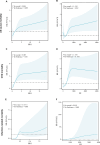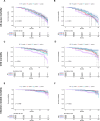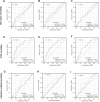Prognostic implications of systemic immune-inflammation index and systemic inflammation response index in hemodialysis patients
- PMID: 40597013
- PMCID: PMC12220103
- DOI: 10.1186/s12882-025-04223-y
Prognostic implications of systemic immune-inflammation index and systemic inflammation response index in hemodialysis patients
Abstract
Objectives: Patients undergoing hemodialysis (HD) face high mortality, mainly from cardiovascular disease (CVD), infections, and dialysis withdrawal. Systemic inflammation contributes significantly to these outcomes. This study aimed to examine the associations between the systemic immune-inflammation index (SII) and systemic inflammation response index (SIRI) with all-cause, CVD, and infection-related mortality in HD patients, and to evaluate their prognostic value.
Methods: We conducted a retrospective analysis of 1190 HD patients recruited between January 2012 and December 2016. Kaplan-Meier survival curves, Cox regression analysis, and restricted cubic spline (RCS) models were employed to explore the associations between SII, SIRI, and all-cause, CVD, and infection-related mortality. In addition, receiver operating characteristic (ROC) curves was used to determine the predictive accuracy of SII and SIRI.
Results: Among the 1190 patients (median age 62.0 years; 64.0% male), the all-cause mortality rate was 38.2%, while the CVD mortality rate was 16.9%. Adjusted Cox regression analyses revealed that patients in the highest SIRI quartile (quartile 4) had significantly elevated risks of all-cause (hazard ratio [HR] 2.29, 95% CI 1.38-3.80, P = 0.001), CVD (HR 3.78, 95% CI 1.43-10.01, P = 0.007), and infection-related mortality (HR 2.42, 95% CI 1.70-3.01, P < 0.001) compared to those in the lowest SIRI quartile. Similar associations were found for SII (P < 0.001). Kaplan-Meier curves demonstrated comparable results. RCS analysis revealed nonlinear relationships between SII, SIRI, and mortality risk (P < 0.05). ROC analysis highlighted that Both SII and SIRI demonstrated moderate to strong prognostic value, with SIRI consistently offering the best risk stratification.
Conclusions: Elevated levels of SII and SIRI are linked to higher risks of all-cause, CVD, and infection-related mortality in HD patients. SIRI appears to be a more reliable predictor of mortality risk. Future studies should explore the underlying mechanisms and validate the predictive value of SII and SIRI for mortality risk among HD patients.
Clinical trail number: Not applicable.
Keywords: All-cause mortality; Cardiovascular disease mortality; Hemodialysis; Systemic immune-inflammation index; Systemic inflammation response index.
© 2025. The Author(s).
Conflict of interest statement
Declarations. Human ethics and consent to participate declarations: Ethics Committee of The Traditional Chinese Medicine Hospital of Pujiang County approved the study (2024C04), Written informed consent was obtained from all study subjects in accordance with the Declaration of Helsinki. Consent for publication: Not applicable. Competing interests: The authors declare no competing interests.
Figures




Similar articles
-
Impact of systemic immune inflammation index and systemic inflammation response index on all-cause and cardiovascular mortality in cardiovascular-kidney-metabolic syndrome.Eur J Med Res. 2025 Jul 21;30(1):645. doi: 10.1186/s40001-025-02929-1. Eur J Med Res. 2025. PMID: 40685352 Free PMC article.
-
Correlation between CBC-derived inflammatory indicators and all-cause mortality with rheumatoid arthritis: a population-based study.Front Med (Lausanne). 2025 Jun 10;12:1538710. doi: 10.3389/fmed.2025.1538710. eCollection 2025. Front Med (Lausanne). 2025. PMID: 40557044 Free PMC article.
-
Predictive value of systemic inflammatory indices for perinatal outcomes following cervical cerclage: a retrospective cohort study.BMC Pregnancy Childbirth. 2025 Jul 10;25(1):750. doi: 10.1186/s12884-025-07888-3. BMC Pregnancy Childbirth. 2025. PMID: 40640782 Free PMC article.
-
Systemic pharmacological treatments for chronic plaque psoriasis: a network meta-analysis.Cochrane Database Syst Rev. 2021 Apr 19;4(4):CD011535. doi: 10.1002/14651858.CD011535.pub4. Cochrane Database Syst Rev. 2021. Update in: Cochrane Database Syst Rev. 2022 May 23;5:CD011535. doi: 10.1002/14651858.CD011535.pub5. PMID: 33871055 Free PMC article. Updated.
-
Systemic pharmacological treatments for chronic plaque psoriasis: a network meta-analysis.Cochrane Database Syst Rev. 2017 Dec 22;12(12):CD011535. doi: 10.1002/14651858.CD011535.pub2. Cochrane Database Syst Rev. 2017. Update in: Cochrane Database Syst Rev. 2020 Jan 9;1:CD011535. doi: 10.1002/14651858.CD011535.pub3. PMID: 29271481 Free PMC article. Updated.
References
-
- Anand SK, et al. Machine-learning based subgroups of AL amyloidosis and cumulative incidence of mortality and end stage kidney disease. Am J Hematol. 2024. - PubMed
MeSH terms
LinkOut - more resources
Full Text Sources
Medical

